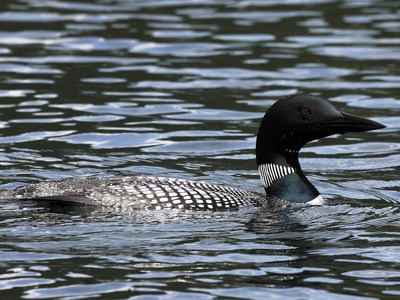Early June, quiet morning. The lake quiet, perfect reflections glisten in the clear morning air.
The sun rises to the east in a pure blue sky. It lights the shore on the west while the eastern shore remains in darkness. Brilliant shades of yellow and pale green on the right contrast with the deeply black shadows among the various greens of the pines to the left.
Quiet is an illusion on a spring morning. Song sparrows, warblers, woodpeckers all sing out: to find a mate, to defend a territory, to seek out food, and perhaps simply to celebrate the coming of warmer days.
The loons are quiet this morning. Several pairs in our area returned from winter holidays in the south. They come north to enjoy with us the clean quiet lakes, the long, warm days, and the bright starry nights.
Off in the far, far distance, a loon calls. One of four songs the loon brings to the lake, this one is a tremolo. This call is described as a sort of laughter — and nearly always the loon is in flight. One of my reference books suggests that this call indicates alarm — something has disturbed the loon, it takes fight. (The Loon, Voice of the Wilderness, by Joan Dunning, is an excellent book that describes the life cycle of this mysterious creature.)
Nearby, I hear the loon that lives in our bay call out with a wail. A long, clear note, often heard from great distances. I think of this call as reaching out to her mate — a long drawn out “Where aaaare you?”
Closer now, I hear the loon in flight, singing out the tremolo — oo-ooo-ooo-oo-oooo. Listening more carefully, I hear it is two loons flying together. Soon they are overhead, not much higher than the trees, flying east.
The nearby loon on the water calls still louder, closer, a long mournful wail. Of course it only sounds mournful to me. To the loon, she may just be saying that she’d like her mate to come out fishing with her this morning.
I don’t hear the other two calls loons make this morning. The yodel we hear most often at dusk, or in the middle of the night. Dunning suggests it is a song that defines, and defends territory. “...a slow, rising note followed by several undulating phrases.” You know this song, ooooooooo-oo-oooooooooo-oo- oooooooooooo — this is the song of an early summer night.
The fourth call of the loon is a short, quiet hoot or kwak. I have only heard them use this after the little chicks join them, and perhaps stray too far on the water. It is indeed a very personal word that the parents have with their little ones.
Hopefully we will soon be seeing loon chicks on the lake.
We watched the nearby pair dance in courtship rituals in May. They swim together and fish together. But in the past couple of weeks, we have seen just one loon at a time. We think the other is on the nest. Over the next few weeks we’ll keep watching, and listening and wonder each morning, will we have a family of loons on our bay this year?
Viki Mather has been writing for Northern Life since the spring of 1984. During 2011, she takes us back to some of those older writings as she prepares to publish a book of ‘In the Bush’. This one was originally published in the spring of 2001.
-Posted by Vivian Scinto
Join Sudbury.com+
- Messages
- Post a Listing
- Your Listings
- Your Profile
- Your Subscriptions
- Your Likes
- Your Business
- Support Local News
- Payment History
Sudbury.com+ members
Already a +member?
Not a +member?
Sign up for a Sudbury.com+ account for instant access to upcoming contests, local offers, auctions and so much more.
